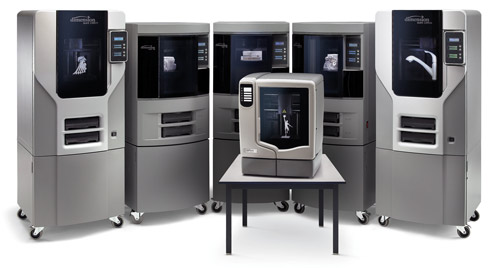 As a longtime fan of science fiction I have always had a fascination with future technology speculation and why I (and most fans) enjoyed Star Trek: The Next Generation. It was on that show that the replicator (first used on the original 1960’s series) began to deliver much more than food and drink: it could create any inanimate matter, as long as the desired molecular structure was on file in the computer.
As a longtime fan of science fiction I have always had a fascination with future technology speculation and why I (and most fans) enjoyed Star Trek: The Next Generation. It was on that show that the replicator (first used on the original 1960’s series) began to deliver much more than food and drink: it could create any inanimate matter, as long as the desired molecular structure was on file in the computer.
Eden Prairie-based Stratasys, Inc. (Nasdaq: SSYS), the leading manufacturer of 3D printers and 3D production systems, announced this week that it has signed a definitive agreement with HP for Stratasys to manufacture an HP-branded 3D printer. Used by product designers and architects, Stratasys 3D printers create three-dimensional plastic models directly from 3D digital designs. Though 3D printing is by no means even close to a Star Trek-like replicator, the rapid prototyping capability, marked reductions in cycle times in design and innovation, coupled with the capability to manifest 3D computer aided designs (CAD) in to physical objects is poised for a global expansion that is likely to be quite dramatic.
Though this 3D printing category is in its early stages, Stratasys Chairman and CEO Scott Crump stated in the announcement that, “We believe the time is right for 3D printing to become mainstream. We also believe that HP’s unmatched sales and distribution capabilities and Stratasys FDM technology is the right combination to achieve broader 3D printer usage worldwide. HP has made a similar move in this market before, capturing a dominant position in large-format 2D printers. Together we hope to repeat this success with 3D printers.”
Why is this a particularly interesting category and what is the relevance for Minnov8?
These 3D printers from Stratasys deliver rendered parts directly from CAD files. Though it’s a bit of a stretch to compare 3D printing to the explosion in print caused by the desktop publishing movement in the late 1980’s (and, of course, a replicator!), the price reduction in 3D printing — and an expectation that HP global distribution will accelerate price declines and increase capability in these devices — means it’s likely that there will be a subsequent acceleration in use of these devices worldwide, sharing of designs, and a facilitation of mass customization capabilities that could prove interesting for smart entrepreneurs in the internet and web space.
If one considers the quite successful Threadless business model — a community driven tee-shirt company with all designs coming in from users and voted on by the community at large — there is no question that less expensive 3D digital printing will create an increase in design-driven and distributed innovation in mechanical engineering. Imagine an increase in 3D content libraries with a robust marketplace for CAD drawings (e.g., 3D Content Central).
Stratasys has competition from low end makers like MakerBot, a home and hobbyist 3D printing vendor, and higher end ones like 3D Systems with respective prices in the $1,000 range to multiple thousands.
Some are not sold on this deal between HP and Strasys. Joseph Flaherty, a self-described “personal fabrication enthusiast” has a blog called Replicator and he is clearly skeptical about this deal and said so in his post, “HP + Stratasys = No Big Deal“:
My guess would be that Stratasys facing a portfolio of expiring patents gave a great deal to a massive marketing partner in the hopes of quickly increasing their install base. It also gives the Stratasys stock a nice bump after a dismal year keeping shareholders happy. This deal could work out great, or in a years time HP could realize that there are a bunch of partners with new and improved technology and leave Stratasys for a newer, shinier partner. In any case HP is just taking on the B2B sales channel so it will still be a while still before we can pick up a Stratasys at Staples. It is exciting for sure, I just wouldn’t expect it to change the market dynamics drastically.
Though Mr. Flaherty comes at this deal from the perspective of a home user vs. a commercial one, it will be interesting to see if this deal is a game changer or not.
What intrigued me was the video below from Jay Leno’s Garage that showed a Stratasys-made (and delivered by a California-based value added reseller) that demonstrates one aspect of why these sorts of 3D printers are so powerful:
It will be interesting to watch Stratasys and the 3D printing market as it progresses. Who knows…maybe you entrepreneurs will soon have one in your house and be creating designs you’ll send off to be manufactured!